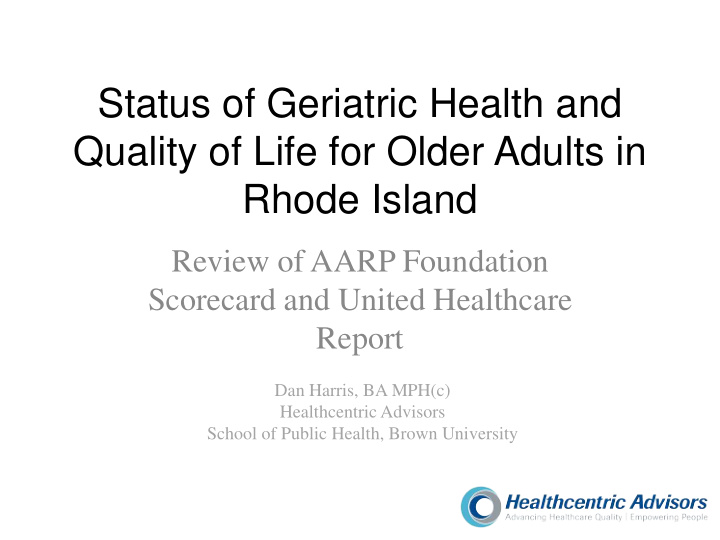



Status of Geriatric Health and Quality of Life for Older Adults in Rhode Island Review of AARP Foundation Scorecard and United Healthcare Report Dan Harris, BA MPH(c) Healthcentric Advisors School of Public Health, Brown University
Presentation Goals Describe the population of older adults living in Rhode Island Review and critique the AARP and United Healthcare reports’ methods Discuss the main findings Identify opportunities for intervention
Aging in Rhode Island “Demographic transition” 30.0% 24.7% 24.5% 25.0% 23.1% Percent of Adults > 65 20.7% 20.0% 18.0% 15.9% 14.4% 15.0% 10.0% 5.0% 0.0% 2010 2015 2020 2025 2030 2035 2040 Source: RI Statewide Planning Projections, 2013
Older Adults in Rhode Island (> 65) Characteristic % White 92% Female 58% Income below poverty level 10% Living with a disability 35% Self-care difficulty 7% Difficulty ambulating 24% Lives alone 32% Source: American Community Survey 2014
? AARP State Scorecard: A systems approach “PICKING UP THE PACE OF CHANGE”
Rhode Island’s Overall Rank 10 11 32 38
Five AARP Domains Quality of life and quality Affordability and Access Choice of setting and of care provider 34 24 30 Support for family Effective transitions caregivers 35 22
A National Leader In Measure Rank 2017 Percent of long-stay nursing homes residents hospitalized 5 within a six-month period (2014) Support for working caregivers (2014-2016) 5 Medicaid services per 100 people with ADL disabilities (2012) 6 Percent of high-risk nursing home residents with pressure sores 12 (2013)
Positive Changes In Measure Rank 2014 Rank 2017 Median annual nursing home 44 48 private pay cost as a percentage of median household income age 65+ Percent of Medicaid and state 44 50 LTSS spending going to HCBS for older people & adults w/ physical Percent of high-risk nursing home 12 21 residents with pressure sores (2013)
Opportunities for Improvement Showed no improvement from 2014 to 2017 reports 1. Medicaid aged long-term service users receiving services in the community ( 2017 Rank 42 ) 2. Percent of home health patients with a hospital admission ( 2017 Rank 30 ) 3. Percent of new nursing home stays lasting 100 or more days ( 2017 Rank 43 ) 4. Percent of residents who successfully transition back to the community after 90+ days in the nursing home ( 2017 Rank 46 )*
A “health” approach UNITED HEALTHCARE SENIOR REPORT
Selected Performance Measure Rank Nursing home quality 6 Smoking 8 Obesity 8 Dental visits 14 Excessive drinking 19 Pain management 32 Physical inactivity 30 Poverty 42 Community support 45
Strengths & Weaknesses Strengths Weaknesses High SNAP enrollment Low percentage of volunteerism Nursing home quality Seniors in poverty Low prevalence of obesity Low community support expenditures
Bridging the Reports: Community Determinants United Healthcare Report
Bridging the Reports: Community Determinants United Healthcare Report AARP Report
Discussion • Opportunities for upstream intervention(s)? – What community-level support systems are successful? Unsuccessful? Missing? – Diversifying care settings – Policy recommendations • Opportunities for dissemination? – Public and academic • Recommendations for analysis and reporting
Recommend
More recommend